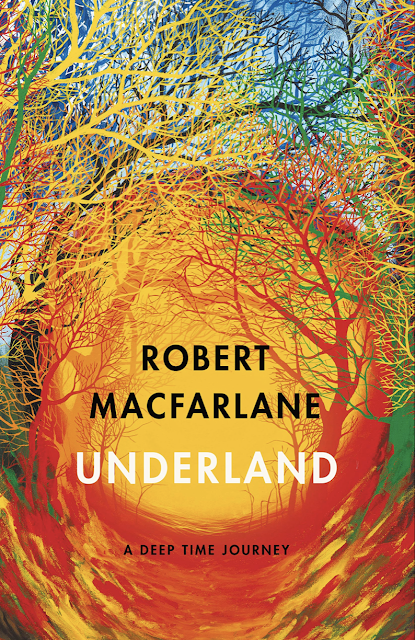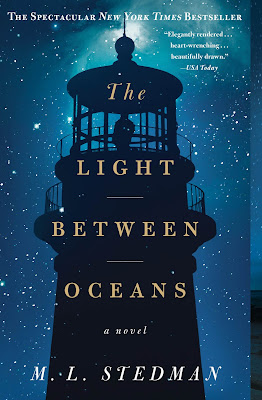"Underland: A Deep Time Journey" by Robert Macfarlane (published 2019)
Bury the past as deep as you like - whatever you do - if you don't make true peace with it - it'll come back to haunt you. You must make peace with it. For its substantially conceptual heft, Underland: A Deep Time Journey is an easy-going, fascinating book of intense exploration that is concerned with what the unseen says about that which coexists with it as it goes unnoticed. Author Robert Macfarlane is concerned with uncovering parts of this Earth that many, if not most, cannot visualize - and this is not entirely due to its geography. In the Introduction, he writes: "An aversion to the underland is buried in language. In many of the metaphors we live by, height is celebrated but depth is despised. To be 'uplifted' us preferable to being 'depressed' or 'pulled down'. 'Catastrophe' literally means a 'downwards turn', 'cataclysm' a 'downwards violence'. A bias against depth also runs through mainstream conventions of observation and representation. In his book Vertical, Stephen Graham describes the dominance of what he calls the 'flat tradition' of geography and cartography, and the 'largely horizontal worldview' that has resulted."
Suffice it to say, the places Macfarlane is interested in are very deep underground. Macfarlane gives readers access to geological worlds underneath the topographical landscape we see and walk atop of every day. It must be noted: Macfarlane isn't going to these dangerous places way beneath the earth as a thrill-seeker, adventurer, or conquerer of lands: though that may be part of it. He goes to understand the story of the unseeable buried structures that have been preserved (either naturally or otherwise) to find out what this can tell us about humanity; to grasp the knowledge it renders through its forms and from what has been left there.
Three places are visited within Underland: Part I features areas within Britain, Part II features areas within France, Italy, and Slovenia, and Part III features places in Norway, Greenland, and Finland. Underland Britain has much to do with the horror of mining and just how complex these underground places, indeed, more like towns, really are, how much space or how little the men had to work within, their skeletons now preserved by the rock, the livings' death tolls of freak accidents, the land of Bronze Age funeral barrows and hunter/gatherer artifacts. Macfarlane goes "caving" in Britain and what he learns is on the one hand terrifying and on the other exciting. The former is so because of the technological equipment/machinery used and just left buried within natural geological wonders - then - eerily how it becomes one with the cave at an odd juxtaposition of meaning. The latter because of the fact of how these structures uphold themselves through time: think of how limestone is created. Later, he explores the understorey of a British forest, then goes back to the mine caves, all the while weaving in myth and fable, science and art into his own burgeoning comprehension of this new/old world of the below.
In France, Macfarlane explores the catacombs, going without sunlight for days at a time. The catacombs underneath the city of Paris is a city in itself, and pretty much anarchic. With a sharp critical eye, Macfarlane explores his mixed feelings about these lived in catacombs while experiencing the traversal of them himself. Needless to say some of those feelings included a deep, primal fear as he shimmied (though this word is too mild) his way through these living tombs. In Italy, there are underground rivers and grottos. The water almost becomes magical and readers will join Macfarlane in his enchantment with it. In Slovenia, Macfarlane struggles with places that are both haunted by their past yet are so beautiful because of it. There are sinkholes. Peaks. Cave systems. Glacier caves. More. Norway: the cave paintings that bring a man to tears. Oil hunting and its' devastating effects. Greenland: cities of fallen ice, the memory of ice, the blue of ice. Aurora Borealis. Finland: the burial of nuclear waste.
Macfarlane's excellent penchant for writing along with his expertise makes for brilliant, jaw dropping chapters that only continues to get better as the book continues. He does not neglect history. In fact, Underland is rife with it. To read Underland is to become immersed in a warm blanket of language that allows you to connect with Macfarlane on levels of claustrophobia, relief, loneliness, stoicism, and awe. These are not typical emotions, and the journey you will enter with him is one of a kind and unforgettable.
My review is an extremely crude outline of this phenomenal book. It is a must read that avoids focusing on the trauma of the dying world and hones in on a celebration of life that is bittersweet, hopeful, cynical yet brimming with possibility.
Some of Underland's most poignant moments for me were the long-due and long-deserved emergence of Macfarlane from his underland visits. The colors were all new. Sunlight is a real thing again. Insect life becomes something else entirely. At one point in his journey Macfarlane looks up, and storing this in his own moment in his memory he ends up writing one of the most gorgeous lines I've ever read:
"Far to the north-east a patch of blue shows in the clouds, and for a few seconds there is a glitter of light out on the water below. For those seconds I love that blue with all my heart, dream-dive deep into it, drown it its hue."




Comments
Post a Comment